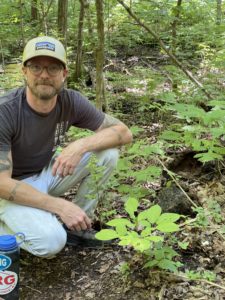
“There’s kind of a legend about ginseng,” according to Ethan Swiggart, a plant scientist at Middle Tennessee State University. The legend goes something like this: Ginseng “shows itself to you.” And if you’re not ready? Then you won’t find it.
I’m hoping that’s not the case today.
Swiggart is leading me on a hike in search of wild ginseng, on public land in Rutherford County. (We aren’t disclosing the exact location because ginseng is an endangered plant.) He says his team at MTSU’s International Ginseng Institute has known about this particular patch for a while, and a colleague wanted to see it for himself.
MORE: This Is Nashville — Conserving Tennessee’s rare and endangered plants
“He spent about three hours, got lost back in here and never found it,” Swiggart says with a chuckle. “So the joke was like, ‘Well, you weren’t ready.’”
For what it’s worth, I feel ready.
In search of the perfect spot
As we make our way into the woods, Ethan points out the trees along the way — mostly pine and other evergreens. The ground is rocky, so much so that we’re often hopping between boulders. Swiggart says we’re not likely to find ginseng in these conditions. Though you may find Virginia creeper, which is often confused for wild ginseng.
“People always will say, ‘Oh, man, I’ve got like five acres of ginseng,’” Swiggart says, laughing. “And I’m like, ‘No, you don’t. Five acres of ginseng? You’re sitting on like $1,000,000. No way.’”
Five acres of Virginia creeper: not worth anything.
As we move on, the landscape around us begins to change. The ground is less rocky, and there are more maple trees. These are signs that we’re getting closer. Now it’s time to start looking for the ideal spot: a gently sloping, northeast-facing hillside. Swiggart says the slope helps with drainage. Ginseng likes to be well-watered but not soggy. In other words: just right.
 Steve Haruch, WPLN
Steve Haruch, WPLN Hiking through the woods in search of ginseng
“They’re pretty persnickety,” Swiggart says.
At this point, we’ve been out hiking for an hour, which is about twice as long as we had planned. But even though it’s hot and muggy, the hike itself is pretty enjoyable. It’s shady under the trees, and there’s a chorus of birds and cicadas around us.
Swiggart says that when he talks to old ginsengers — or “sangers” — they often talk about “the moments of spending time with their grandfather, dad, and hiking in the woods, crawling under brush and stuff. Just having fun.”
Moments like these.
But also moments like: checking the GPS again. (The signal is weak out here in the woods.) Moments like: circling back the way we came; going left … no, maybe it’s right; wandering onto the wrong trail; seeing Virginia creeper and momentarily getting our hopes up; spotting plants like golden seal that often grow near ginseng; doubling back on the trail yet again.
That kind of thing goes on for a while today.
More ginseng lore
As we get turned around, Swiggart takes full advantage of the chance to school me on ginseng. It’s been cultivated for thousands of years for its medicinal benefits. Native Americans used the root to treat everything from headaches to infertility. High blood pressure? Take wild ginseng. Low blood pressure? Take wild ginseng. It’s sometimes called a miracle plant. And that’s because really, it can be whatever you need it to be. Swiggart likens it to a cigarette.
“You might smoke it if you needed to get amped up. Might smoke if you need to calm down,” he says. “A different effect depending on what you want. Ginseng is kind of like that.”
It’s easy to see why it’s so valuable. But not all ginseng is created equal. Swiggart tells me that the gnarlier the root, the better. Wild ginseng will be much gnarlier than cultivated ginseng, because it’s lived a harder life. That is part of its value. Also, the more the root is shaped like a human, the more valuable it is. Especially if it has a “penis,” Swiggart says.
Of course, it’s nearly impossible to know how gnarly a root is, or how it’s shaped, from above ground. And it’s nearly impossible to see at all, against a backdrop of other green, leafy things — even if you know exactly what you’re looking for. Which, thankfully, Swiggart does.
Ready to be seen
 Steve Haruch, WPLN
Steve Haruch, WPLN Ethan Swiggart of MTSU’s International Ginseng Institute, kneeling beside a wild ginseng plant
When we finally find the ginseng, Swiggart actually has to jump to avoid stepping on it. He’s ecstatic.
“That’s a huge one,” he exclaims. “Good grief. Walked right past it!”
He crouches down to show me: This plant has four prongs and is beginning to flower. It really is beautiful. But why did it take so long for us to find, in an area that Swiggart has visited numerous times? He has a theory.
“Told you, right? If it doesn’t want to be seen, it won’t.” We did the right thing, though, he says: “We slowed down, we chilled out, and then — boom, there it is.”
All that time, the ginseng was there, hiding in plain sight. We had already passed through that area twice. But ginseng is endangered, and cultivation is highly regulated in Tennessee. So, even after all this, we leave it right where we found it, and head back.
Steve Haruch is senior producer for This Is Nashville. He has a lot of spreadsheets open right now. You can find him on Twitter @steveharuch or contact him directly at [email protected].


